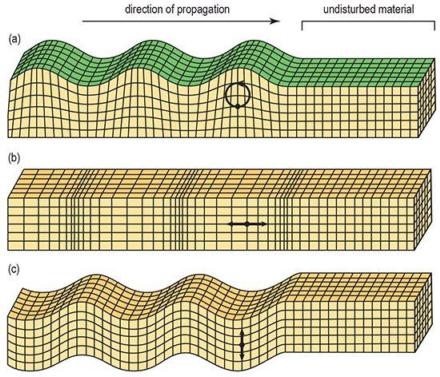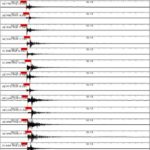Seismic wave
Seismic wave, vibration generated by an earthquake, explosion, or similar energetic source and propagated within the Earth or along its surface. Earthquakes generate four principal types of elastic waves; two, known as body waves, travel within the Earth, whereas the other two, called surface waves, travel along its surface. Seismographs record the amplitude and frequency of seismic waves and yield information about the Earth and its subsurface structure. Artificially generated seismic waves recorded during seismic surveys are used to collect data in oil and gas prospecting and engineering.
Parameters That Influence Seismic Velocity
Fundamental Observations of Rock Physics
• Velocities almost always increase with effective
pressure. For reservoir rocks they often tend toward
a flat, high pressure asymptote.
• To first order, only the difference between confining
pressure and pore pressure matters, not the absolute
levels of each — ”effective pressure law.”
• The pressure dependence results from the closing of
cracks, flaws, and grain boundaries, which elastically
stiffens the rock mineral frame.
• The only way to know the pressure dependence of
velocities for a particular rock is to measure it.
• Make ultrasonic measurements on dry cores; fluidrelated
dispersion will mask pressure effects.
• The amount of velocity change with pressure is a
measure of the number of cracks; the pressure range
needed to reach the high pressure asymptote is a
measure of crack shape (e.g. aspect ratio).
• Velocities tend to be sensitive to the pore fluid
content. Usually the P-wave velocity is most
sensitive and the S-wave velocity is less sensitive.
• Saturation dependence tends to be larger for soft
(low velocity) rocks.
Stanford Rock Physics Laboratory
Read also
Velocities depend on fluid modulus and density
• When going from a dry to water saturated rock,
sometimes the P-velocity increases; sometimes it
decreases.
• The rock elastic bulk modulus almost always
stiffens with a stiffer (less compressible) pore fluid.
• The stiffening effect of fluid on rock modulus is
largest for a soft (low velocity) rock.
• The bulk density also increases when going from a
dry to water-saturated rock.
• Because velocity depends on the ratio of elastic
modulus to density, the modulus and density
effects “fight” each other; sometimes the velocity
goes up; sometimes down.
• Measures of modulus ( ), impedance
( ), and don’t have
the density effect “ambiguity.”
• Be careful of ultrasonic data! At high frequencies,
the elastic-stiffening effect is exaggerated for both
bulk and shear moduli; so we don’t often see the
density effect in the lab and the velocities will be
contaminated by fluid-related dispersion.





